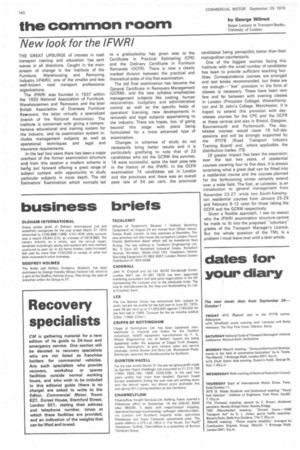New look for the IFWRI
Page 142

If you've noticed an error in this article please click here to report it so we can fix it.
THE GREAT UPSURGE of interest in road transport training and education has sent waves in all directions. Caught in the main stream of change is the Institute of the Furniture, Warehousing and Removing Industry (IFWRII, one of the smaller and less well-known road transport professional organizations.
The IFWRI was founded in 1937 within the 1920 National Association of Furniture. Warehousemen and Removers and the later British Association of Overseas Furniture Removers, the latter virtually a specialized branch of the National Association. The Institute is concerned with giving a comprehensive educational and training system for the industry, and its examination system includes management subjects as well as operational techniques and legal and insurance requirements.
In the last two years there has been a major overhaul of the former examination structure and from this session a modern scheme is being put forward offering a great range of subject content with opportunity to study particular subjects in more depth. The old Estimators' Examination which normally led to a graduateship has given way to the Certificate in Practical Estimating (CPE) and the Ordinary Certificate in Furniture Removals (OCFR). There is now a clearly marked division between the practical and theoretical sides of this first examination.
The old final examination has become the General Certificate in Removers Management (GCRM), and the new syllabus emphasizes management subjects like costing, human relationships, budgetary and administrative control as well as the specific fields of operators' licensing, new developments in removals and legal subjects appertaining to the industry. There are hopes, too, of going beyond this stage with plans being formulated for a more advanced type of examination.
Changes in schemes of study do not necessarily bring better results and it is particularly gratifying to note that of 23 candidates who sat the GCRM this summer, 18 were successful, quite the best pass rate in the history of the IFWRI. In the OCFR examination 74 candidates sat in London and the provinces and there was an overall pass rate of 54 per cent, the provincial
candidates-being perceptibly better than their metropolitan counterparts.
One of the biggest worries facing this Institute with the small number of candidates has been to provide sufficient teaching facilities. Correspondence courses are arranged and text books recommended, but these are not enough—"live" provision in the form of classes is necessary. These have been very few and far between with evening classes in London (Princeton College), Wolverhampton and St John's College, Manchester. It is hoped to extend this provision with dayrelease courses for the CPE and the OCFR at these centres and also in Bristol, Glasgow, Bournemouth and Portsmouth. The day' release courses would cover 16 full-day sessions and will be strongly supported by the RTITB (Road Transport Industry Training Board) and, where applicable, the distribution trades. ITB.
Of greater impact has been the expansion, over the last two years. of residential courses covering four to five days. It is always surprising what a great deal can be fitted into a residential course and the courses planned for the forthcoming winter certainly extend over a wide field. The first, at Leicester, is an introduction to general management from November 23-27, while two South Kensington residential courses from January 25-29 and February 8-12 cater for those taking the OCFR and the GCRM respectively.
Given a flexible approach. I see no reason why the IFWRI examination structure cannot be made to fit into the proposed "voluntary" grades of the Transport Manager's Licence, But the whole question of the -11V1L is a problem I must leave over until a later article.


























































































































































































